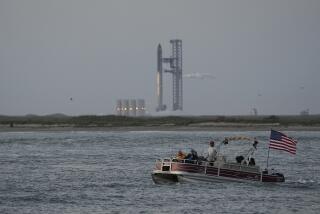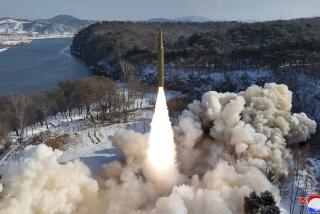Experimental aircraft speeds to more than 3,000 mph in test flight
A lightning-quick experimental aircraft made history when it sped more than 3,000 mph above the Pacific Ocean in a test flight, reigniting decades-long efforts to develop a vehicle that could travel faster than a speeding bullet.
The unmanned X-51A WaveRider, which resembles a shark-nosed missile, was launched midair Wednesday off the coast near Point Mugu. It sped westward for 240 seconds, reaching Mach 5.1, or more than five times the speed of sound, before plunging into the ocean as planned.
The X-51A, built and tested in Southern California, was powered by an air-breathing engine that has virtually no moving parts. It flew for longer than any other aircraft of its kind and traveled more than 264 miles in little more than six minutes.
A passenger aircraft traveling at that speed could easily fly from Los Angeles to New York in less than an hour.
âIt was a full mission success,â Charlie Brink, X-51A program manager for the Air Force Research Laboratory Aerospace Systems Directorate, said in a statement. âI believe all we have learned from the X-51A WaveRider will serve as the bedrock for future hypersonics research and ultimately the practical application of hypersonic flight.â
While supersonic flight refers to velocity that exceeds the speed of sound, hypersonic flight refers to going five times the speed of sound or more.
Since the 1960s, the Air Force has been flirting with hypersonic technology, which can propel vehicles at speeds that cannot be achieved from traditional turbine-powered jet engines. But the technology has been exceedingly difficult to perfect. Previous attempts produced very limited results.
In Wednesdayâs test flight, the X-51A took off from Edwards Air Force Base, slung under the wing of a B-52 bomber. At about 50,000 feet, it was released like a bomb and engaged a solid rocket booster that accelerated it to Mach 4.8 in about 26 seconds.
After separating from the booster, the X-51A scramjet engine then lit and accelerated to Mach 5.1 at 60,000 feet.
The way the cruiserâs scramjet engine works is: hydrocarbon fuel is injected into the scramjetâs combustion chamber where it mixes with the air rushing through the chamber and is ignited in a process likened to lighting a match in a hurricane.
The X-51A then is designed to ride its own shock wave. Thatâs how the cruiser earned the WaveRider nickname.
After the flight, the X-51A broke up after splashing into the Pacific. There are no plans to recover it.
While the aircraft was designed to reach Mach 6, engineers said they were happy because the program objective was to prove the viability of air-breathing, high-speed scramjet propulsion.
This was the last of four test X-51A vehicles originally conceived when the $300-million technology demonstration program began in 2004. None of the other flights went the distance.
Work on the X-51A was done by Boeing Co.âs research center in Huntington Beach and Pratt & Whitney Rocketdyne in Canoga Park. All told, 370 seconds of data were collected from the experiment.
Aerospace engineers say that harnessing technology capable of sustaining hypersonic speeds is crucial to the next generation of missiles, military aircraft, spacecraft -- and even passenger planes.
The Pentagon believes that hypersonic missiles are the best way to hit a target in an hour or less. The only vehicle that the military has in its inventory with that kind of capability is the massive, nuclear-tipped intercontinental ballistic missile. Other means of hitting a distant target, such as cruise missiles and long-range bomber planes, can take hours to reach their destination.
The Pentagon itself has funded major hypersonic technology programs over the last several decades, most notably with the X-15 rocket plane that was built by North American Aviation and flew a half-century ago.
Over the last 10 years, the Pentagon said it spent as much as $2 billion on hypersonic technologies and supporting engineering.
For now, there is no immediate successor to the X-51A program. But the Air Force will continue hypersonic research and the successes of the X-51A will likely find its way to the high-speed strike weapon program, which is currently in its early formation phase.
ALSO:
Boeing profit surges 20% despite 787 woes
Supersonic flight brings Virgin Galactic closer to space
Investigators sent to Afghan air base where cargo plane crashed [Video]
More to Read
Inside the business of entertainment
The Wide Shot brings you news, analysis and insights on everything from streaming wars to production â and what it all means for the future.
You may occasionally receive promotional content from the Los Angeles Times.











